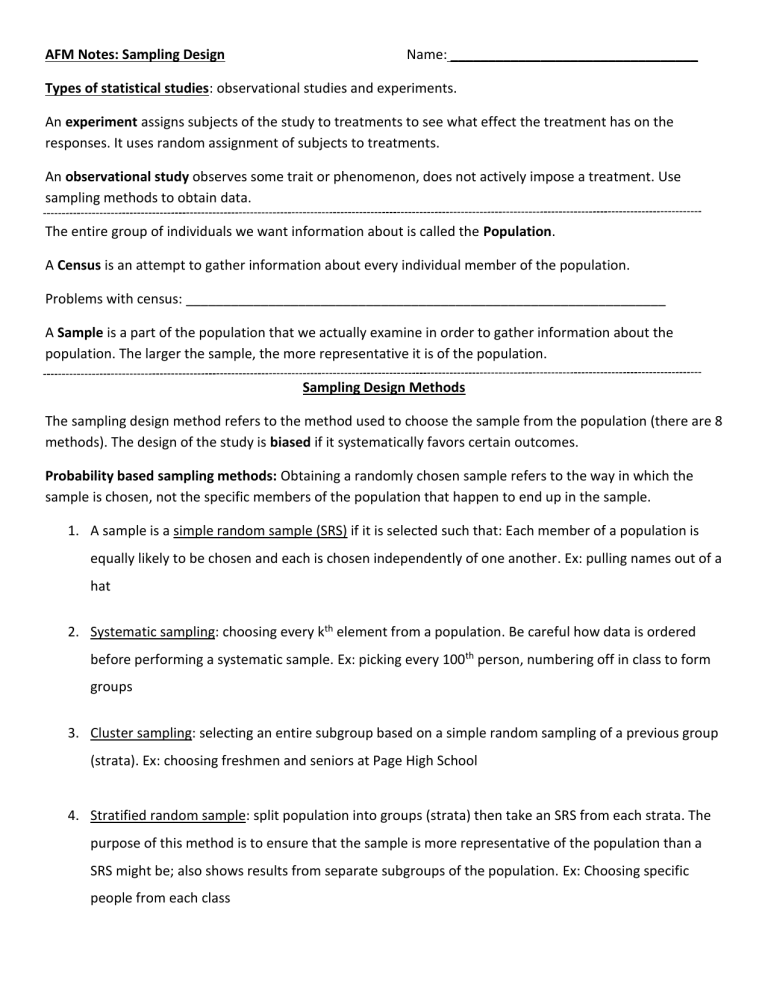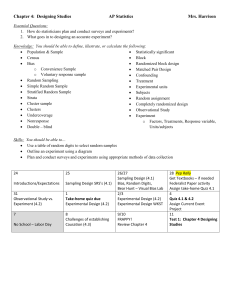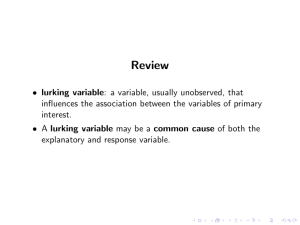
AFM Notes: Sampling Design Name: _________________________________ Types of statistical studies: observational studies and experiments. An experiment assigns subjects of the study to treatments to see what effect the treatment has on the responses. It uses random assignment of subjects to treatments. An observational study observes some trait or phenomenon, does not actively impose a treatment. Use sampling methods to obtain data. The entire group of individuals we want information about is called the Population. A Census is an attempt to gather information about every individual member of the population. Problems with census: ________________________________________________________________ A Sample is a part of the population that we actually examine in order to gather information about the population. The larger the sample, the more representative it is of the population. Sampling Design Methods The sampling design method refers to the method used to choose the sample from the population (there are 8 methods). The design of the study is biased if it systematically favors certain outcomes. Probability based sampling methods: Obtaining a randomly chosen sample refers to the way in which the sample is chosen, not the specific members of the population that happen to end up in the sample. 1. A sample is a simple random sample (SRS) if it is selected such that: Each member of a population is equally likely to be chosen and each is chosen independently of one another. Ex: pulling names out of a hat 2. Systematic sampling: choosing every kth element from a population. Be careful how data is ordered before performing a systematic sample. Ex: picking every 100th person, numbering off in class to form groups 3. Cluster sampling: selecting an entire subgroup based on a simple random sampling of a previous group (strata). Ex: choosing freshmen and seniors at Page High School 4. Stratified random sample: split population into groups (strata) then take an SRS from each strata. The purpose of this method is to ensure that the sample is more representative of the population than a SRS might be; also shows results from separate subgroups of the population. Ex: Choosing specific people from each class Difficulties with probability sampling: sometimes subjects could share similar characteristics (ex gender); could eliminate certain subgroups Non-probability based sampling methods: not representative of a population, typically biased. 5. Self-selected sample (voluntary sample): when people participate in a surveyif they want to; strong opinions are represented (positive or negative). Ex: American Idol, internet polls, voting system 6. Convenience sample: choosing a sample because it is close in proximity or easy to contact. Ex: Choosing people that are nearby or who are easy to reach out to such as friends and family 7. Judgment Sampling: Sampling people who are experts. Ex. Asking doctors when is the best time to taka a flu shot 8. Quota Sampling: A specific number of individuals are chosen out of a specific subgroup. For example, a researcher might ask for a sample of 100 females, or 100 individuals between the ages of 20-30. Sources of bias in sample designs: a selection is bias if it favors certain outcomes or groups of people. a) selection bias or undercoverage: Too small number of responses that distort the data. Ex: 20 responses to represent an entire school population b) measurement bias: results overstate or understate the actual measurement. Ex: If a scale is not properly calibrated, it might consistently understate weight. In this case, the measuring device -- the scale -- produces the bias. Human observation can also produce bias. c) response bias: The person conducting the survey or the respondents impart their own opinion to get a desired outcome. Ex: putting favorite at the top of a list d) non-response bias: When a chosen individual cannot be reached or does not respond Ex: In a class survey if people are absent or do not respond






